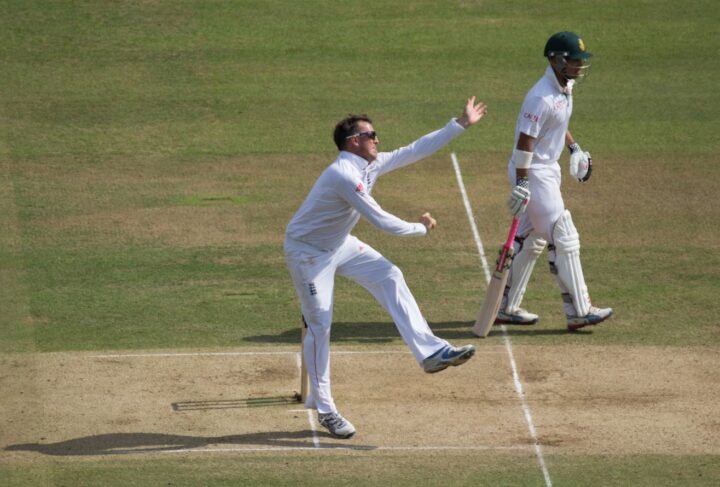Today we welcome new guest writer James Ogden to TFT. He argues that it’s vital to preserve 5-day Test cricket, and believes that the compelling game at Cape Town couldn’t have come at a better time.
2020 started with a whimper in the cricketing world. The first T20I between India and Sri Lanka was abandoned without a ball being bowled due to water seeping through the covers. Australia completed a 3-0 rout of a disappointingly uncompetitive New Zealand, and England started the new year in age old fashion, collapsing from 221-5 to 269 all out.
More worryingly, however, is that all this was happening while cricket’s authorities (mainly the ECB and Cricket Australia) were considering a most bizarre and depressing idea to ‘save’ long format cricket.
The prospect of 4-day Tests, an idea that will supposedly save the players from burnout, and save less affluent nations money, is extremely controversial. Even the least cynical fans find it hard to believe that the newly unshackled days won’t be ravaged by yet more T20 schemes. Thus, any cricket fan waking up before day 5 of the Cape Town Test had every right to feel gloomy. But you know what they say – time can be a great healer. And so it proved …
In the shadow of Table Mountain and The Devil’s Peak, a group of 22 men toiled in the sun and dirt to fight the gathering forces threatening our game. The platform was laid on day 4 by the grit of Sibley and the swashbuckling flamboyance of Stokes, but to prove that time really is a healer the Proteas had to step up – and that they did.
Elgar and Malan dug in to survive the new ball, and it needed a beauty from Anderson to get the home team two down at the close of play. In we went, to what could soon be an obsolete fifth day, and what a day it was. Malan excellent, De Qock skilled, Philander resolute, Stokes indescribable.
8.2 overs. That is all that remained of this incredible ever-flowing test when Stokes finally found Philander’s edge. Du Plessis claimed this was the reason that people played tests, and the Barmy Army sang songs and waved their flags in the fading African sun.
Yet this didn’t feel like the fading light of a dying sport. Indeed the previous 36 hours had completely changed the feel of cricket – and man was it needed.

The result between England and South Africa was somewhat inconsequential. The result for cricket is what reverberated around the world. Just as two of the big three associations were scheming to forever change the nature of Test cricket, we witnessed a classic that may well save it for the time being.
Joe Root himself said after the match that the sport should probably resist change – a volte face from what he suggested beforehand. His sentiment echoed that of Gambhir, Tendulkar and Atherton – all stalwarts of game. Maybe the brilliance of Cape Town gave these old masters the confidence to speak up and defend an institution that they still hold dearly to their hearts?
The time the likes of Sibley and Malan ate up at the crease could well have just bought the 5-day test a few more years. Those who suggest that losing a day will make the game quicker, and thus more easily engage the casual fan, overlook the joys of true test cricket. The fever pitch takes longer to be reached, the water simmers for longer on the stove, but when it boils over the joy and relief is so much sweeter.
The ecstasy felt by England when Curran finally took Malan’s edge, or the delight when Stokes got his two wickets in two balls, is indescribable to anyone not partial to the red ball game. Yet, to anyone there or watching on the television, the emotions of pain or relief would have felt even more pronounced due to the length of the rocky journey we took to reach that point.
Cape Town was a reminder of how the 5-day format plays with your emotions over time. That is the true power of test cricket. Good things come to those who wait.
Those 22 men in the African dirt may never know what they did for our sport, but anyone watching it knew. Stokes steaming in, Philander puffing out his chest, flying one-hand catches, all in the last hour of a 5-day marathon of skill and determination. It encapsulated precisely why Test match cricket is the greatest of all sports.
Time has given 5-day cricket power again. Now let us hope this power can give Test cricket more time.
James Ogden









It is pretty much as hard to argue with any of this as to believe in the good intentions of people who have given us the likes of The Hundred (aka Harrison’s Harebrained Have a Hit), and plotted to create a new ODI tournament involving India, England, Austrralia and A N Other and now talk about reducing tests to four days.
Good piece. Agree entirely.
I see the ECB don’t give a stuff though as they’ve just posted the 100 prices. Blimey I wouldn’t go if they paid me £35.
They still want like 85 quid for a family!!! for 200 balls.. RIP OFF
I don’t think anyone on this blog would argue with the fact that test cricket is inimitable, it’s just whether the ECB consider it passe in this age of instant gratification.
You’re preaching to the traditionalists on this blog, try addresssing these concernes and arguments to the powers at be and see what reaction you get and there’s the rub.
It doesn’t seem to matter, even if the players agree test cricket is the ultimate age challenge, once the ECB feel that public involvement with the format is on the wain they’ll see that as a valid excuse to downgrade it.
Test cricket is very popular here which is why the ECB’s support for 4-day Tests seems curious on the surface. The main argument in favour of shortening games is that less affluent boards can’t afford to stage 5 days. So are the ECB proposing shorter Tests for altruistic / philanthropic reasons? I fear not. Everything else they do – like the big three coup at the ICC a few years back and this proposed new big three annual ODI tournament – generally screws less affluent nations over.
The argument the ECB will be using in private is that they can squeeze in more white ball games, whilst talking about payer welfare etc in public. The problem we’ve got is that the poorer nations will support 4-day Tests through financial necessity, and the ECB / ACB will support 4-day Tests through greed. Sadly, therefore, I expect 4-day Tests to happen one day. Which is why I think James O’s article is apt. It really could be just a matter of time. I just hope that when 4-day Tests come in they aren’t mandatory.
Not sure the ECB have ever talked about, or even thought about payer welfare James, but good typo! I can’t see why on earth 4 days would be more appealing than 5. As we know, few people watch on TV, even fewer can afford to go to watch every day of a match, certainly in England, and apparently cricket has to appeal now to those whose attention span lasts as long as a game of football. So what’s with the idea that 4 days would bring in more casual fans?
James is 100% spot on
The ECB want 4 days tests for the following reasons:
1) They have little to no interest in developing County Cricket 4 day game
2) They realise that their system is NOT producing Red ball players and so 99% of ‘Tests’ are simply 4 one day knocks currently. Old fashioned one day knocks granted but it’s all ‘push the game forward’ type stuff
3) They want more time slots for White ball Games/Competitions.. Purely to make more money
$) They wanted to create this stupid big 3 + 1 White ball ‘tournament’… again.. purely for money
5) ECB know the smaller countries are on the same curve with regards to the style of player being produced so they know they also have no interest in Tests.. That means they can back this Now rather than 8-10 years ago (which is when I think they decided to fully committ to white ball systems) in public rather than just in private.. Again.. purely for cash
There is quite simply no evidence that ‘everyone’ prefers White ball over Tests. Whatever metric you use to justify can be counter argued with very valid reasons.
The reality currently is… There is more money int the game than ever before.. and yet.. we have less people watching, less people following and less people playing the game than ever and that has been falling for 18+ years and is only increasing in speed. Baring in mind that white ball has been massive since 2008 and has STILL NOT actually grown the game (unless you literally just talk about TV revenue which is a white elephant as that’s just TV companies out bidding purely to gain market share.. not actually because of demand.
I would dispute that test cricket here is ‘very’ popular. Footie is very popular. Test Cricket fills 30,000 capacity stadiums, depending on whom we are playing, 15-20 days a year. Even when the grounds are full anyone who has been watching test cricket for any time knows the crowds are becoming increasingly boisterous and less involved in the game, with their fancy dress and Mexican waves, often in direct conflict to what is happening on the field.
Terrestrial TV wouldn’t touch it at present as they’re not confident it would attract an audience to justify 8 hour days coverage, or if on commercial TV, who would rush to advertise on it.
Test cricket on day five only gets a decent crowd if a home win is on the cards. The main problem is it involves taking time off work, usually at the last minute, which is why ticket prices are normanlly slashed. As most tests don’t get to day 5 these days and the breeding grounds for the players are state and county matches that last 4 days, why not.
There may not be evidence that everyone prefers white ball but the organisers, who presumably have conducted marketing surveys before they invest time and money into promoting it, are convinced that it is the future direction for the game if it is to survive in an increasingly congested market place.
It’s no good just using immotive argument and selective statistics as fact, it’s a sign of the times that all professional sport is in direct competition for an increasingly sedentary audience.
What all sports need are stars achieving enough success to promote the game to the general public. Without this the game itself will not grow and the fact remains it is easier to make a dramatic impact as a cricketer in white ball than in red. Stokes is a rare exception to that rule. The classic example is Roy, not good enough to make an impact in tests, but an iconic figure in the annals of white ball. To sell a sport to advertisers and sponsors you need figureheads, the more dramatic the better.
great article, but as pointed out, we here don’t need any convincing. Speaking from Oz, in the last few days, Tim Paine and a few other current players came out in support of 5 days. But of course they are in the proverbial cleft stick, cant be seen to be too critical of their employer. But oddly enough, albeit in a back handed way, Cricket Australia have just given Harrison et al a real backhander by scheduling some white balls games in our winter (to be played in Darwin) against Zimbabwe. Wonderful from the perspective of giving Zimbabwe some exposure and inclusion, but also because contracted C A players (think Smith, Warner) will have to be available for those games rather than off having a hit somewhere in the U K and learning to count to 100.
Yep good point Mick. Australia’s big guns won’t be around for The Hundred now. So no India players, no first choice Aussies, and England players will only be available for bits and pieces. The Hundred’s foreign legion already mainly consisted of imports who have played county cricket anyway. Now the so called world class field will be even less exotic / star studded.
This really isn’t going well for the ECB – one reason, I suspect, why the ticket prices for The Hundred (kids for a fiver) announced yesterday are so low. I think they’re beginning to panic.
Costs aren’t that low though.. 80 odd quid for a family to go to see 200 balls. I’d say that’s pretty darn expensive for a ‘new’ influx of Mums and Kids
The reality is that tickets will be given away for free to schools, clubs and little initiatives like ‘street cricket’ etc etc. THis will ensure there are people at the grounds at least. They’ll also sell tickets to beer heads just like 2020 does as they don’t exactly support cricket generally either (and they already make up a vast majority of 2020 crowds).
Add to that the die hard ECB supporters who will happily keep going to the shorter and shorter format games irrespective.
The competition will do fine because the ECB can’t afford for it to fail so they’ll pull out all the stops and people are sheep.. if the media sell it to you that it’s ‘great’ or a player is ‘world class’.. just look what happens.. suddenly it’s the greatest game, greatest format, greatest player ever.
We see this all the time with the ECB.. England players as you all know are sold to us as Greats, world class.. world class potential… The fact they win bugger all and consistently under perfom is swept under the carpet.
This Bairstow’s failings
Stokes avg 35 (although the last 12 months he’s obviously improved beyond measure)
Root’s decline
Roy being sold to us as a potential great red ball player and the hype around him with people saying he’ll be great
Hales in the past
Curran being sold to us as some great all rounder.. test batsmen in the making…
They are masters at propaganda after all so what they want, they’ll get
etc etc etc
Interesting to see Giles come out strongly aginst the idea. His relationship with Graves and Harrison is worth keeping an eye on. On the other hand, Strauss gave a more equivocal response and his view matters more because he’s on the ICC Cricket Committee which is where the idea goes next.
Although the ECB and CA are utterly cynical in their exploitation of the issue, their point about Test cricket struggling in some ‘smaller’ nations does contain some truth. I’m not judging this by crowd sizes but by, for example, SL cancelling their planned Test against Ireland. What people can’t do is support five-day Tests and not support serious reforms to support Tests in these nations. That’s a recipe that will kill Test cricket more circuitously but just as surely as the four-day plan. I’ve repeatedly listed here what I think such reforms might be (which is not of course to rule out other ideas – and I don’t expect help to come without some strings attached that involve boards like SL and WI significantly improving their performance).
BTW, I don’t think four-days is the end of their plans – it’s just a stepping stone. The next step will be two innings per side of fixed numbers of overs.
“two innings per side of fixed numbers of overs.”
This is exactly what I think they are progressing to. I actually think it’s already been decided that is the direction of travel and has been in place for many years now. THey are just going to milk it for as much money as they can until then.
As for the smaller nations.. Not only are they smaller/Poorer anyway BUT.. If the ECB, BCCI and CA can’t produce specialists for the different formats.. what hope do SL, WI, PK, NZ,SA, ZIM, Ireland etc stand. The answer… NONE
Test Cricket is so vastly different to the skills needed in White ball that player cross over isn’t easy. This England side is proof of that. How many of this side would actually be good white ball players (for top teams)…. 2.. maybe 3. Even the rest have been compromised in some way by the white ball mentality